De Havilland Puss Moth
| DH.80 Puss Moth | |
|---|---|
 |
|
| de Havilland DH.80A Puss Moth G-ABLS first registered in 1931 | |
| Role | Light utility aircraft |
| Manufacturer | de Havilland |
| First flight | 9 September 1929 |
| Introduction | March 1930 |
| Produced | 1929-1933 |
| Number built | 284 |
The de Havilland DH.80A Puss Moth is a British three-seater high-wing monoplane aeroplane designed and built by the de Havilland Aircraft Company between 1929 and 1933. It flew at a speed approaching 124 mph (200 km/h), making it one of the highest-performance private aircraft of its era.
The unnamed DH.80 prototype which first flew in September 1929 was designed for the flourishing private flying movement in the United Kingdom. It was a streamlined all-wooden aircraft fitted with the new de Havilland Gipsy III inverted inline engine that gave unimpeded vision across the nose without the protruding cylinder heads of the earlier Gipsy II engine.
After the prototype was tested, the aircraft was redesigned with a fabric-covered steel-tube fuselage and as such redesignated the DH.80A Puss Moth. The first production aircraft flew in March 1930 and was promptly sent on a sales tour of Australia and New Zealand. Orders came quickly and in the three years of production ending in March 1933, 259 were manufactured in England. An additional 25 aircraft were built by de Havilland Canada. Most were fitted with the 130 hp (97 kW) Gipsy Major engine that gave slightly better performance.
The Puss Moth was replaced on the production line by the de Havilland DH.85 Leopard Moth that, with a plywood fuselage, was both cheaper to build, and lighter weight. Being lighter, the Leopard Moth had better performance on the same rather modest 130 hp (97 kW) Gipsy Major engine.
Early in its career, the DH.80A was plagued by a series of fatal crashes, the most famous being to Australian aviator Bert Hinkler while crossing the Alps in CF-APK on 7 January 1933. The cause was eventually pinned down to "flutter" caused by turbulence leading to wing failure - this was corrected by stiffening the front strut with a jury strut to the rear wing root fitting. One aircraft took part in the Challenge 1934 European tourist plane contest, but dropped out because of an engine fault on one of the last stages.
Most DH.80As were used as private aircraft, though many also flew commercially with small air charter firms for passenger and mail carrying. Seating was normally two although in commercial use two passengers could be carried in slightly staggered seats with the rear passenger's legs beside the forward passenger seat. The wings folded backwards for storage, pivoting on the rear spar root fitting and the V-strut root fitting, a system used on other De Havilland light airplanes of the period.
...
Wikipedia
